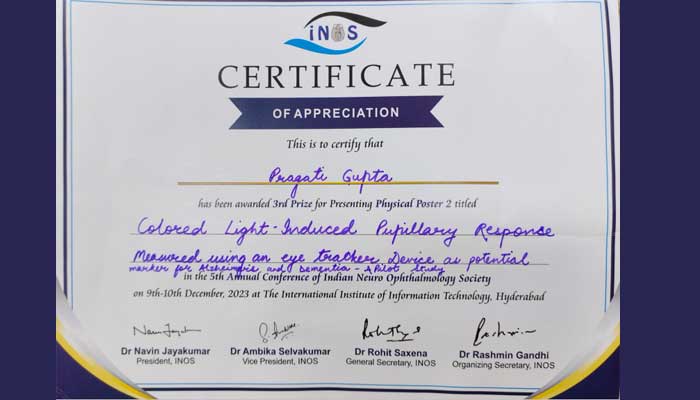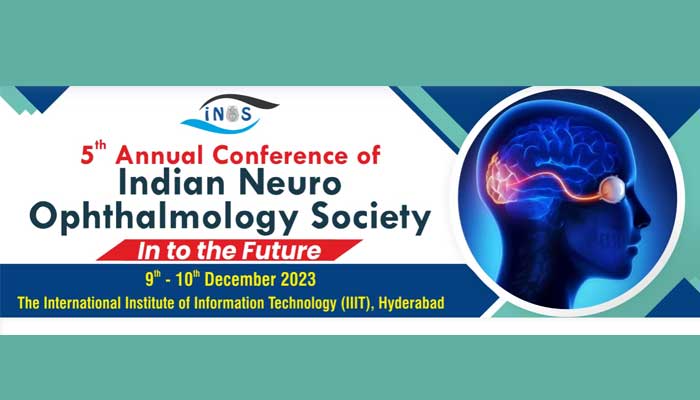Pragati Gupta supervised by Dr. Kavita Vemuri won third prize at INOS-2023 in poster session for their research work on Binocular Pupillary Response to Chromatic Light as Potential Marker- A Preliminary Observation at the 5th Annual Conference of Indian Neuro Ophthalmology Society held from 9 – 10 December at International Institute of Information Technology, Hyderabad (IIITH). The poster session had more than 40 entries. The study at its nascent stages of clinical validity looks at binocular pupillary response as markers for dementia/Alzheimer’s. The data was collected from patients over a period of 3-4 months at 2 hospitals in the city. The other authors of this research work are Bhumika Sahu, JRF candidate; Nikunj Nawal, UG2k18- CSD and Dr Rashmin Gandhi, Neuro-ophthalmologist- Centre for Sight, Hyderabad. They were the only non-medical/clinical team with research in this area.
Research work as explained by the authors: The pupillary response is a mechanism of the eye that regulates the size of the pupil in response to changes in light intensity. Altered pupillary light responses (PLR) may be linked to Alzheimer’s disease (AD) due to abnormalities in either the retina or the efferent pupillary system. Most clinical testing is with white light (torch light) using pupillometry. This preliminary study focuses on observing the binocular pupillary response to coloured light recorded with a Tobii(X30) eye tracker connected to a laptop screen (Brightness: 65%, Contrast:70%) placed at a distance of 56 cm from the participant. Post calibration, under dim illumination, data was collected from elderly participants (N=13) with dementia/Alzheimer’s. Participants were shown eight-coloured screens in the order – Red(R), Green(G), Blue(B), Yellow(Y), Black (Bl), White(W), Indigo(I), and Purple(P), each for 3 seconds. A grey coloured-screen is shown for 3 seconds between two consecutive colours for adaptation and baseline calculation. Maximum constriction/dilation velocity (MCV/MDV), maximum constriction/dilation amplitude (MCA/MDA), and latency were calculated for stimuli. The amplitude and latency were referenced to age-matched healthy participants (Lobato-Rincón et al., 2014). We observed a change in PR for I, P & Y (higher) as well as G and R (lower) in MCA and a higher latency for G, while previous studies report differential response to blue wavelength. Our study included a broader range of coloured lights (including the effect of lower wavelengths) to examine the loss of RGCs reported in AD (Rukmini et al., 2017). We are extending this observational study by increasing the sample size and extracting the range in PR parameters as a function of wavelength and clinical conditions.
The conference was aimed at doctors and researchers who covered case studies, best practices and research opportunities, with a focused attempt to bring technology into clinical diagnosis.
More details at: https://www.inosindia.com/INOS-2023/

January 2024

